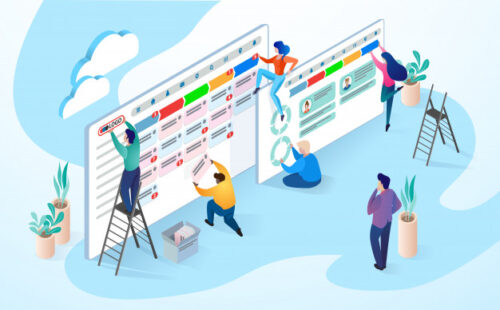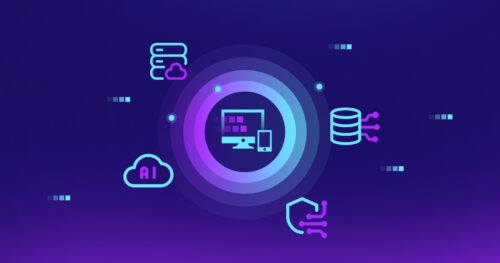Microservices architecture plays an important role in creating scalable, resilient, and innovative software solutions for organizations on the path to digital transformation. This approach is ideal for complex systems with the capability for high-speed development and heterogenous technology. Leveraging our expertise in software architecture, DigitalMara has prepared this guide to best practices for microservices, which covers the benefits, the technologies used, and other important considerations.
Understanding microservices architecture
Microservices are no longer seen as a new concept. However, this kind of architecture has become increasingly essential as businesses face the growing limitations of their legacy systems. These old monolithic applications are built on large, complex, and tightly interconnected architecture. They are difficult to upgrade, scale, or add new features to, without risking the entire system’s stability.
Microservices architecture addresses these challenges by breaking down complex applications into smaller, independent services. Each microservice focuses on a specific business function, operates independently, and communicates with other services through APIs. Choosing legacy software upgrading allows businesses to gradually transition to microservices, updating one component at a time. As a result, they gain a modern solution that meets industry standards and user requirements.
Regular surveys conducted by Statista and Gartner show that many respondents are choosing microservices as a leading architectural approach. However, it isn’t necessarily the best option. In some cases, a well-architected monolith application may be more efficient and easier to manage. Your choice should be technically grounded. This table shows a comparison of microservices vs monolithic architecture:
| Feature | Microservices architecture | Monolithic architecture |
| Definition | A design style that structures an application as a collection of small, independent services. | A design style where all components of an application are built as a single unit. |
| Scalability | Each service can be scaled independently. | The entire application must be scaled together. |
| Development | Separate teams can work on different services simultaneously. The codebase can be managed in separate repositories for each service. | Development is done in a unified codebase. The codebase is managed in a single repository. |
| Deployment | Services can be deployed independently. And different services can be versioned independently. | The entire application must be deployed together. And there is a single version for the entire application. |
| Testing | Requires testing of individual services and their interactions. | Testing is done on the entire application as a single unit. |
| Reusability | Services can be reused across different projects. | Limited reusability outside the application. |
| Fault isolation | Failure in one service does not affect the others. | Failure in one part of the system can affect the entire application. |
| Data storage | Each service can have its own database. Data management is decentralized. | A single database is used for the entire application. Data management is centralized. |
| Maintenance | Easier to update and maintain individual services. | Updates and maintenance affect the entire application. |
| Flexibility | High flexibility to adopt new technologies and changes. | Less flexible due to tight coupling of components. |
| Performance | Can introduce latency due to inter-service communication. | Typically has lower latency within the application. |
| Management | More complex to manage due to multiple services. Changes in one service do not affect others, reducing risk. | Simpler to manage as a single unit. Changes can affect the entire application, increasing risk. |
| Communication | Services communicate over a network using APIs. | Components interact through method calls within the application. |
| Cost efficiency | Can be more cost-efficient by optimizing resources per service. | Might require over-provisioning resources to handle peak loads. |
| Technology evolution | Easier to adopt new technologies in individual services. | Harder to adopt new technologies due to tight integration. |
Benefits of microservices architecture for business
By choosing microservices architecture for their systems, businesses can drive innovation and operational excellence. This shift towards modularity and independence principles offers a range of benefits that significantly enhance a company’s ability to scale, adapt, and optimize resources.
Independent scaling of specific functions
Microservices enable dynamic scaling and resource allocation based on current system demands. Moreover, they allow these adjustments to be automated. For example, consider an e-commerce platform where the user authentication service and the payment processing service experience different loads. During peak shopping periods, such as sales and holidays, the payment processing service may face significantly higher traffic compared to the authentication service. With microservices, the payment processing service can be scaled independently to handle the increased load, without the need to scale the authentication service unnecessarily. This targeted scaling ensures efficient use of resources and maintains optimal performance.
Faster development cycles and deployment
Microservices facilitate faster development cycles and deployment processes, surpassing the capabilities of monolithic architectures. Thus, in a monolithic system, any change, no matter how small, requires rebuilding, testing, and deploying the entire application. This results in longer release cycles and delays in bringing new features to the market. In contrast, microservices allow independent services to be developed, tested, and deployed separately, enabling more frequent updates and quicker delivery of new features. Furthermore, continuous integration with microservices ensures that each service can be automatically tested and integrated, significantly improving the efficiency and reliability of the development process.
Resilience and reliability
Microservices architecture enhances the resilience and reliability of applications by designing services to be independent and isolated. This means that a failure in one service does not directly affect other services, allowing the application to continue functioning even if one or more services fail. This isolation improves fault tolerance and enhances the overall reliability of the system. However, the impact of a service failure still depends on the specific service that is out of order, its relationships with other services, and its overall importance within the system.
Consider a logistics platform where the order processing, shipment tracking, and inventory management are structured as services. If the shipment tracking service fails, a business can still place orders and manage their inventories, but they might be unable to track the real-time location of their shipments. This failure has less impact compared to others. On the other hand, if the inventory management service fails, the business might face difficulties in managing stock levels and reordering supplies, but existing shipments and orders would remain unaffected. This shows how the isolation of microservices enhances system reliability, while the specific impact of a failure depends on the role.
Optimizing resources and potentially reducing costs
Since each service can be deployed independently, businesses can tailor their infrastructure to meet the specific needs of each service, avoiding the inefficiencies associated with over-provisioning resources for a monolithic application. This granular approach to resource allocation ensures that critical services receive the necessary computing power and storage, while less demanding services use fewer resources.
Moreover, microservices can leverage cloud-native features such as auto-scaling and serverless computing. Auto-scaling allows services to automatically adjust their resource allocation in response to real-time demand, scaling up during peak use periods and scaling down during quieter times. This flexibility ensures that resources are used efficiently and costs are minimized, especially during periods of low activity. The combination of microservices and serverless computing also leads to significant cost savings, as businesses only pay for the actual computing time consumed by their services, rather than provisioning resources that may go unused.
Technologies and tips for microservices development
The approach to implementing microservices varies, depending on whether a business is developing new applications from scratch or is carrying out legacy systems upgrading to transition to a microservices architecture. The first case offers the advantage of designing an optimized, flexible, and scalable system from the outset. Transferring requires more careful planning, incremental migration, and overcoming significant technical and organizational challenges. Despite having their own specifics, these two paths share common goals and principles, including the use of a modern tech stack, APIs, DevOps practices, effective microservices testing and deployment strategies.
When transitioning to microservices, businesses often require specialized skills that may not be readily available in-house. This is where IT outsourcing services and IT staff augmentation can help. By leveraging external resources, companies get expertise to design, develop, and implement microservices for their unique cases.
APIs and Microservices
Microservices communication relies heavily on a number of well-defined APIs. These APIs enable seamless interaction and data exchange between different services. A key component in this setup is the API Gateway, which acts as an admin for microservices, handling requests and directing them to the appropriate service. This not only streamlines the communication process but also enhances security and efficiency, ensuring that the right data reaches the right place without any issues.
In addition to the API Gateway, configuring a service discovery mechanism for microservices is essential for efficient communication. It functions as a dynamic directory that keeps track of all the services within the system. When one service needs to communicate with another, it doesn’t have to know the exact location or address. Instead, it can query the service discovery, which provides the necessary details to establish a connection. This flexibility allows better scaling and resilience, as services can move or change without disrupting the overall communication flow.
Kubernetes and Docker in microservices
Effective implementation of microservices is made possible through containerization. This method encapsulates each service in its own container, allowing it to be developed, deployed, and scaled independently. Containerization in microservices enhances flexibility and enables faster, more efficient updates and maintenance. Key technologies in this realm include Docker and Kubernetes, which streamline the management and orchestration of these containerized services.
Using Docker in microservices allows developers to bundle each service into a container that includes everything needed to run the service: the application code, runtime environment, libraries, and system dependencies. This isolation ensures that microservices run consistently across different environments, from development to production, reducing compatibility issues and enhancing stability. Docker’s efficiency and portability make it an ideal tool for creating and deploying microservices, also supporting DevOps practices.
Using Kubernetes in microservices provides an advanced orchestration system for managing containers at scale. Technology automates the deployment, scaling, and operation of containerized applications, simplifying the management of complex microservices architectures. It handles container lifecycles, schedules and distributes workloads across a cluster, balances loads, and ensures high availability by automatically recovering from failures. Kubernetes also offers features like service discovery, automated rollouts and rollbacks, and secret and configuration management, which are essential for maintaining a robust microservices environment.
Event-driven architecture
Given modern conditions, businesses need to be more agile and responsive than ever and require software solutions that can meet that need. Microservices are also being upgraded to correspond to these requirements. Technology has moved toward event-driven microservices, where the “event” is any interaction with a system. This means that the system responds to events in real time, creating a more dynamic and seamless user experience.
If we take as an example an online store, the initial event will be an order placed by a customer. In response, several services need to be activated immediately. The inventory service checks stock availability, the payment service processes the transaction, and the shipping service prepares for delivery. With event-driven architecture, each of these microservices is triggered automatically by the event, working independently yet in harmony to complete the order efficiently. Different scenarios are possible depending on the response of the services.
Microservices testing strategies
Microservices testing has some specific requirements. Each service must function correctly both in isolation and as part of the larger system. An efficient testing strategy encompasses a wide range of tests, including functional, load, resilience, performance, unit, component, integration, end-to-end, contract, and security tests. To achieve this efficiently, automated testing is essential. It ensures rapid and reliable testing processes that correspond to the fast-paced development cycles typical of microservices architecture. In addition, automated testing enables continuous testing when the number of services grows, supporting robust and resilient microservices deployments.
The need for robust DevOps practices
The adoption of microservices architecture brings benefits but also many new challenges. To address these challenges, robust DevOps practices are essential for ensuring smooth performance and leveraging the full potential of microservices. Primarily, DevOps provides seamless integration and deployment of microservices, supporting frequent updates while reducing the risk of errors and minimizing downtime. Additionally, it secures the system through specialized procedures, while also handling scalability and resource management through automated scaling policies and efficient microservices orchestration.
Being able to manage versions and dependencies is another critical aspect, with DevOps offering tools for efficient version control and compatibility management to facilitate smooth updates and deployments. DevOps also plays a crucial role in microservices performance monitoring, providing real-time visibility into the health and performance of each service, which allows developers to quickly identify and resolve issues, thereby maintaining overall system reliability.
Complementing these practices, microservices deployment strategies emphasize reliability and minimal disruption. Incremental rollouts allow new versions to be deployed gradually to a subset of instances, ensuring continuous service availability. Parallel environments enable developers to deploy and test new versions in one environment while keeping the current version live in another, minimizing downtime and providing an easy rollback mechanism if issues arise. Furthermore, microservices enhance flexibility by enabling feature toggles and phased updates to a small user segment, reducing risks and allowing businesses to respond swiftly to changing market demands and user feedback. Together, these DevOps practices and deployment strategies ensure a smooth transition, maintaining high service reliability and overall system resilience.
Final words
DigitalMara provides comprehensive microservices implementation services across various business domains. Whether you’re looking to build new systems from scratch or transition legacy systems to a modern microservices architecture, our expert team can guide you through every step of the process. We specialize in designing and developing scalable, resilient, and flexible solutions tailored to your specific business needs. Our services also include detailed assessments and strategic planning to ensure a smooth migration, minimizing disruption and maximizing efficiency. With DigitalMara, you can confidently navigate the complexities of microservices, leveraging our expertise to drive innovation and maintain a competitive edge in your industry.
Choose our custom software development or IT team augmentation services.


































